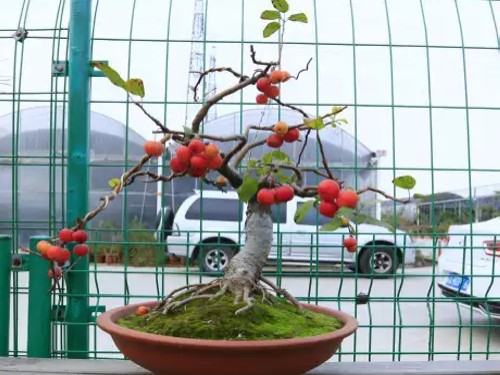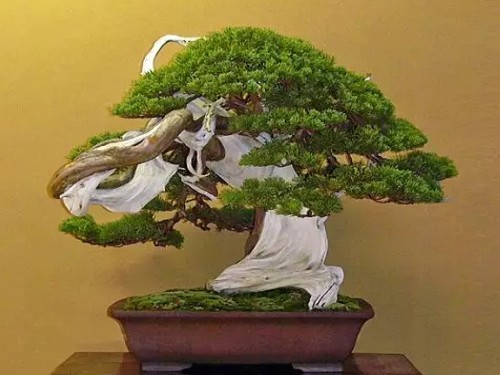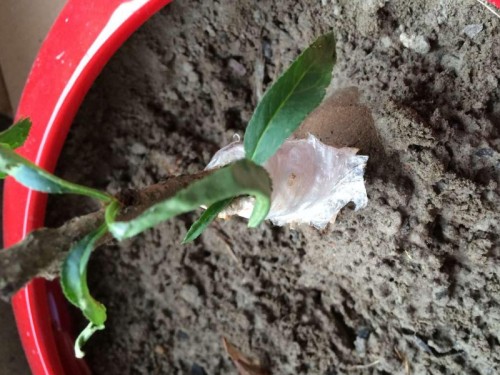The method of making bonsai with winter red fruit
Winter red fruit, also known as longevity fruit, is a deciduous shrub or small tree of the genus Rosaceae, with grayish brown branches, alternate leaves, oval to widely elliptic leaves, green, with round and obtuse serrated edges. Corymbose inflorescences with pale pink flowers blooming from March to April. The fruit is oval, green at first, then yellow gradually, bright red after maturity, single fruit weighs 10-20g, smooth skin, bright color, crystal small, long viewing period, fruitful fruit of the whole plant, does not fall through winter, and is easy to shape. It is an excellent plant material for making bonsai fruit trees.

For the propagation of winter red fruit, the seedlings of apple, bauhinia or begonia can be selected as rootstocks, and the full buds slightly above the middle can be used as scions for bud grafting from early August to late September, or branch grafting can be carried out from March to April next year. The grafting site should not be high, generally 4-6cm from the ground.
Cut the rootstock and wipe it in time in the spring of the following year after grafting to strengthen the nursery management and promote the vigorous growth of scion. Leave pile 6-10cm during winter shearing, increase plant spacing or replant in the coming year, cultivate lateral branches according to modeling design, and complete basic modeling.
At this time, the time of bonsai should be decided according to the direction of bonsai cultivation. If miniature or small bonsai is cultivated, it can be boiled earlier, and if it is rapidly cultivated into medium and large bonsai, the life of bonsai should be postponed, and dwarfing control and modeling training should be carried out in the field.
The winter red fruit used to make bonsai can be grafted with seedlings of begonia, bauhinia and apple stump, which have grown for many years, short plants and strange and simple shapes, with full branches or full buds slightly above the middle as scions, and grafted by splitting, cutting and budding.
The transplanting of rootstocks is generally carried out after defoliation in late autumn and early winter or before sprouting in spring. First planted in tile pots or underground "raise billet", after the survival of the first year of its growth, so that its root system development is perfect, branches are enriched. Wait until the next year before grafting and cut off the excess branches on the rootstock to ensure that there are enough nutrients for the scion to grow.
If the rootstock is a tree-type apple tree, you can also raise the root to the soil surface when changing the pot as needed, so that it can hang its roots and show its claws, which is more ornamental. As the leaves of winter red fruit are larger, the crown is mostly natural, and pay attention to the ventilation and light transmission of its inner chamber, so as to make the fruit grow normally.
According to the shape of the stump, winter red fruit can be made into different forms of bonsai, such as straight dry type, oblique dry type, cliff type, stone-attached type, jungle type, water-dry type and so on. Its branches are soft and can be bent into any shape, so this method is especially suitable for young trees with new pots; for stumps that lack old and simple state, the trunk can also be processed by carving and splitting to make it more perfect.
Time: 2019-05-26 Click:
- Prev

Techniques for making pine and cypress bonsai
Shandong is one of the birthplaces of ancient Chinese culture. On Mount Tai, the head of the five Mountains, there are various kinds of ancient pines on Mount Tai and Houshiwu; in the Zhongjun account ancient temple in Culai Mountain, there are ancient pines that are hundreds of years old; in the loan Temple in Tai'an, some people call the ancient cypress Linghan; in Lingyan Temple and Qufu Konglin, there are many ancient cypresses whose old branches have experienced Cangsang.
- Next

Peach bonsai quick method
A pot of red flowers in the peach bonsai is in full bloom in spring, red if fragrant beads, can if Caixia, dotted with the home, conveying the meaning of spring. Send leaders, bosses, wish grand plans exhibition; send elders, send old people, wish health and longevity; send boys, send girls, wish love a bumper harvest; send relatives, send friends, wish good luck often
Related
- Fuxing push coffee new agricultural production and marketing class: lack of small-scale processing plants
- Jujube rice field leisure farm deep ploughing Yilan for five years to create a space for organic food and play
- Nongyu Farm-A trial of organic papaya for brave women with advanced technology
- Four points for attention in the prevention and control of diseases and insect pests of edible fungi
- How to add nutrient solution to Edible Fungi
- Is there any good way to control edible fungus mites?
- Open Inoculation Technology of Edible Fungi
- Is there any clever way to use fertilizer for edible fungus in winter?
- What agents are used to kill the pathogens of edible fungi in the mushroom shed?
- Rapid drying of Edible Fungi

